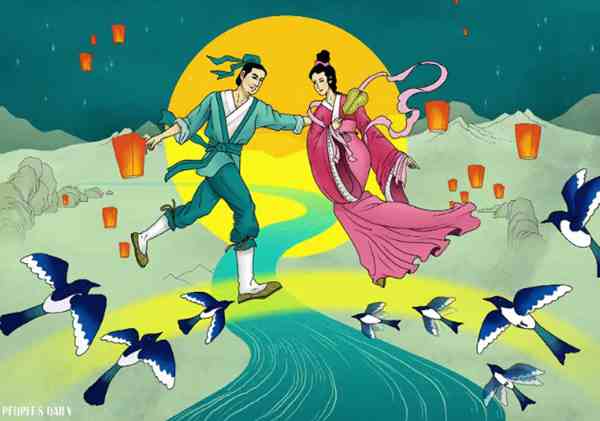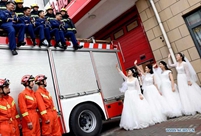

For most young Chinese people, the Qixi Festival, which celebrates the annual gathering of the mythological Cowherd and Weaver Girl, has become a romantic occasion for expressing their affection to their beloved ones. But do you know the origins of this traditional Chinese festival? Is it really the Chinese version of Valentine’s Day? What do people usually do on this unique occasion? Please join us to explore the fun facts and mythology behind the Qixi festival!

Origins
The festival originated from the tale of The Cowherd and the Weaver Girl, one of the four most famous pieces of ancient Chinese folklore. The earliest known reference to this famous myth dates back to over 2,600 years ago, and was told in a poem from the Classic of Poetry.
The story tells of the love between Zhinü (the Weaver Girl, symbolizing Vega) and Niulang (the Cowherd, symbolizing Altair). As the most capable weaver fairy in heaven, Zhinü’s love for Niulang, a mortal, enraged the gods, who separated the couple with the Silver River (symbolizing the Milky Way). Although the gods were consumed with fury, the couple’s love did win some of their sympathy, and they allowed the two to meet over the Silver River once a year. On the 7th day of the 7th lunar month, a flock of magpies would form a bridge so that the lovers could be reunited.
As far back as the Han Dynasty, the practices of the festival were conducted in accordance with formal ceremonial state rituals. Over time, the festival activities also came to include customs practiced by the common people. Though it originated in China, the Qixi Festival inspired the Tanabata festival in Japan, Chilseok festival in Korea, and Thất Tịch festival in Vietnam.
Literature
This beautiful tale of forbidden love has been passed down from generation to generation in China for thousands of years, inspiring Chinese writers, artists and poets to create countless masterpieces on the subject. Since the Zhou Dynasty in the 11th century B.C., poems, popular songs and operas depicting the Qixi Festival’s atmosphere and activities have left us valuable resources with which to better understand how the ancient Chinese celebrated the festival and exactly what they thought about it.
One well-known example comes from the famous Tang Dynasty poet Du Mu, who wrote a poem called “An Autumn Night” to celebrate the Qixi Festival:
银烛秋光冷画屏, A candle flame flickers against a dull painted screen on a cool autumn night,
轻罗小扇扑流萤。 She holds a small silk fan to flap away dashing fireflies.
天阶夜色凉如水, Above her hang celestial bodies as frigid as deep water,
坐看牵牛织女星。 She sat there watching Altair of Aquila and Vega of Lyra pining for each other in the sky.
(Translated by Betty Tseng)
Tradition
Romantic as it sounds, the festival was not originally aimed at lovers, but a festival for girls to demonstrate their domestic skills and to worship the Weaver Girl for her wisdom. Traditionally, girls would take part in worshiping the celestials during rituals, and go to local temples to pray to the Weaver Girl. Paper items were usually burned as offerings, and the girls would recite traditional prayers to bring dexterity in needle work, which in ancient China symbolized the talents and virtues of a good spouse.
Sometimes, contests were held to see who was the best at threading needles under low-light conditions, such as the glow of a half-moon. On this day, Chinese would gaze into the sky to look for Vega and Altair shining in the Milky Way. If it rained on the festival, it meant the couple had been moved to tears by their precious reunion.
In some places, people would build a four-meter-long bridge with large incense sticks and decorate it with colorful flowers. After the proper ritual was observed, the bridge would be burned to bring happiness.
Modern celebration
In modern times, businessmen in China have used the opportunity to market the festival as “China’s Valentine’s Day”, turning it into a highly profitable annual shopping festival.
According to a Xinhua report in 2019, on Alibaba's two major e-commerce platforms Tmall and Taobao, sales of Qixi gifts reached their peak a week before the festival, registering an increase of 118 percent from the previous year. Among them, domestic products were most popular, with sales of traditional Han clothing jumping by 184 percent, while Chinese rouge, an ancient-style blush, saw its sales up over 37 percent from a year earlier.
Compared with the West’s Valentine's Day, data showed that Chinese couples prefer to celebrate Qixi in a more traditionally Chinese way.
A report on the consumption habits of the 2018 Qixi festival published by online food delivery platform Meituan said 42 percent of food consumption on Qixi in 2018 was spent on Chinese cuisine, while on the Western Valentine's Day, it was 35 percent.
 Fire brigade in Shanghai holds group wedding
Fire brigade in Shanghai holds group wedding Tourists enjoy ice sculptures in Datan Town, north China
Tourists enjoy ice sculptures in Datan Town, north China Sunset scenery of Dayan Pagoda in Xi'an
Sunset scenery of Dayan Pagoda in Xi'an Tourists have fun at scenic spot in Nanlong Town, NW China
Tourists have fun at scenic spot in Nanlong Town, NW China Harbin attracts tourists by making best use of ice in winter
Harbin attracts tourists by making best use of ice in winter In pics: FIS Alpine Ski Women's World Cup Slalom
In pics: FIS Alpine Ski Women's World Cup Slalom Black-necked cranes rest at reservoir in Lhunzhub County, Lhasa
Black-necked cranes rest at reservoir in Lhunzhub County, Lhasa China's FAST telescope will be available to foreign scientists in April
China's FAST telescope will be available to foreign scientists in April "She power" plays indispensable role in poverty alleviation
"She power" plays indispensable role in poverty alleviation Top 10 world news events of People's Daily in 2020
Top 10 world news events of People's Daily in 2020 Top 10 China news events of People's Daily in 2020
Top 10 China news events of People's Daily in 2020 Top 10 media buzzwords of 2020
Top 10 media buzzwords of 2020 Year-ender:10 major tourism stories of 2020
Year-ender:10 major tourism stories of 2020 No interference in Venezuelan issues
No interference in Venezuelan issues
 Biz prepares for trade spat
Biz prepares for trade spat
 Broadcasting Continent
Broadcasting Continent Australia wins Chinese CEOs as US loses
Australia wins Chinese CEOs as US loses